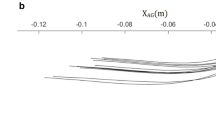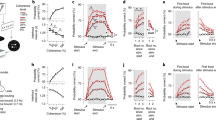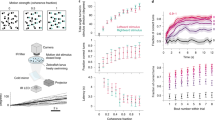Abstract
A systems theory of movement control in animals is presented in this article and applied to explaining the controlled behaviour of the single-celled Paramecium caudatum in an electric field. The theory—General Tau Theory—is founded on three basic principles: (i) all purposive movement entails prospectively controlling the closure of action-gaps (e.g. a distance gap when reaching, or an angle gap when steering); (ii) the sole informational variable required for controlling gaps is the relative rate of change of the gap (the time derivative of the gap size divided by the size), which can be directly sensed; and (iii) a coordinated movement is achieved by keeping the relative rates of change of gaps in a constant ratio. The theory is supported by studies of controlled movement in mammals, birds and insects. We now show for the first time that it is also supported by single-celled paramecia steering to the cathode in a bi-polar electric field. General Tau Theory is deployed to explain this guided steering by the cell. This article presents the first computational model of prospective perceptual control in a non-neural, single-celled system.
Similar content being viewed by others
References
Bernstein NA (1967) The co-ordination and regulation of movements. Pergamon Press, Oxford
Bootsma RJ, Oudejans RR (1993) Visual information about time-to-collision between two objects. J Exp Psychol Hum Percept Perform 19: 1041–1052
Cooper MS, Schliwa M (1985) Electrical and ionic controls of tissue cell locomotion in DC electric-fields. J Neurosci Res 13: 223–244
Craig CM, Lee DN (1999) Neonatal control of nutritive sucking pressure: Evidence for an intrinsic tau-guide. Exp Brain Res 124: 371–382
Craig CM, Delay D, Grealy MA, Lee DN (2000) Guiding the swing in golf putting. Nature 405: 295–296
Craig CM, Pepping G-J, Grealy M (2005) Intercepting beats in predesignated target zones. Exp Brain Res 165: 490–504
Delafield-Butt JT (2007) Towards a process ontology of organism: explaining behaviour in a cell. In: Kelly T, Dibben M (eds) Applied process thought: frontiers of theory and research. Ontos Verlag, Paris
Delafield-Butt JT, Galler A, Schögler B, Lee DN (2010) A perception-action strategy for hummingbirds. Perception 39: 1172–1174
Duffin WJ (1990) Electricity and magnetism. McGraw-Hill, Maidenhead
Field DT, Wann JP (2005) Perceiving time to collision activates the sensorimotor cortex. Curr Biol 15: 453–458
Gibson JJ (1966) The senses considered as perceptual systems. Houghton Mifflin, Boston
Gibson JJ (1977) The theory of affordances. In: Shaw R, Bransford J (eds) Perceiving, acting, and knowing. Erlbaum, Hillsdale
Gibson JJ (1979) The ecological approach to visual perception. Lawrence Erlbaum Associates, Hillsdale
Jahn TL (1961) Mechanism of ciliary movement. 1. Ciliary reversal and activation by electric current—Ludloff phenomenon in terms of core and volume conductors. J Protozool 8: 369–380
Jennings HS (1923) Behavior of the lower organisms. Columbia University Press, New York
Kaiser MK, Mawafy L (1993) Optical specification of time-to-passage: observers’ sensitivity to global tau. J Exp Psychol Hum Percept Perform 19: 1028–1040
Kamada T (1929) Control of galvanotropism in paramecium. J Fac Sci Imp Univ Tokyo IV 2: 123–139
Kamada T (1931a) Polar effect of electric current on the ciliary movements of paramecium. J Fac Sci Imp Univ Tokyo IV 2: 285–298
Kamada T (1931b) Reversal of electric polar effect in paramecium according to the change of current strength. J Fac Sci Imp Univ Tokyo IV 2: 299–307
Kinosita H (1939) Electrical stimulation of paramecium with linearly increasing current. J Cell Comp Physiol 13: 253–261
Lee DN (1976) Theory of visual control of braking based on information about time-to-collision. Perception 5: 437–459
Lee DN (1998) Guiding movement by couopling tause. Ecol Psychol 10: 221–250
Lee DN (2005) Tau in action in development. In: Rieser JJ, Lockman JJ, Nelson CA (eds) Action as an organiser of learning. Erlbaum, Mahwah
Lee DN (2009) General tau theory: evolution to date. Perception 38: 837–858
Lee DN, Reddish PE (1981) Plummeting gannets: a paradigm of ecological optics. Nature 293: 293–294
Lee DN, Young DS, Reddish PE, Lough S, Clayton TMH (1983) Visual timing in hitting and accelerating ball. Q J Exp Psychol A 35: 333–346
Lee DN, Reddish PE, Rand DT (1991) Aerial docking by hummingbirds. Naturwissenschaften 78: 526–527
Lee DN, Vanderweel FRR, Hitchcock T, Matejowsky E, Pettigrew JD (1992a) Common principles of guidance by echolocation and vision. J Comp Physiol A 171: 563–571
Lee DN, Young DS, Rewt D (1992b) How do somersaulters land on their feet. J Exp Psychol Hum Percept Perform 18: 1195–1202
Lee DN, Davies MNO, Green PR, Vanderweel FRR (1993) Visual control of velocity of approach by pigeons when landing. J Exp Biol 180: 85–104
Lee DN, Simmons JA, Saillant PA, Bouffard F (1995) Steering by echolocation: a paradigm of ecological acoustics. J Comp Physiol A 176: 347–354
Lee DN, Craig CM, Grealy MA (1999) Sensory and intrinsic coordination of movement. Proc R Soc Lond B 266: 2029–2035
Lee DN, Georgopoulos AP, Clark MJO, Craig CM, Port NL (2001) Guiding contact by coupling the taus of gaps. Exp Brain Res 139: 151–159
Leon MI, Shadlen MN (2003) Representation of time by neurons in the posterior parietal cortex of the macaque. Neuron 38: 317–327
Li ZG, Milgram P (2008) An empirical investigation of a dynamic brake light concept for reduction of rear-end collisions through manipulation of optical looming. Int J Hum–comput Stud 66: 158–172
Ludloff K (1895) Untersuchungen uber den galvanotrpisum. Arch Ges Physiol 59: 525–554
Merchant H, Georgopoulos AP (2006) Neurophysiology of perceptual and motor aspects of interception. J Neurophysiol 95: 1–13
Merchant H, Battaglia-Mayer A, Georgopoulos AP (2004a) Neural responses during interception of real and apparent circularly moving stimuli in motor cortex and area 7a. Cereb Cortex 14: 314–331
Merchant H, Battaglia-Mayer A, Georgopoulos AP (2004b) Neurophysiology of the parietal–frontal system during target interception. Neurol Clin Neurophysiol 1: 1–5
Offen RJ, Roberts AM (1973) The relations between membrane potential and parameters of ciliary beat in free-swimming Paramecium caudatum. J Exp Biol 59: 583–593
Ogawa N, Oku H, Hashimoto K, Ishikawa M (2006) A physical model for galvanotaxis of paramecium cell. J Theor Biol 242: 314–328
Regan D, Hamstra SJ (1993) Dissociation of discrimination thresholds for time to contact and for rate of angular expansion. Vis Res 33: 447–462
Schogler B, Pepping G-J, Lee DN (2008) Taug-guidance of transients in expressive musical performance. Exp Brain Res 189: 361–372
Sun H, Frost BJ (1998) Computation of different optical variables of looming objects in pigeon nucleus rotundus neurons. Nat Neurosci 1: 296–303
Tan H-RM, Leuthold AC, Lee DN, Lynch JK, Georgopoulos AP (2009) Neural mechanisms of movement speed and tau as revealed by magnetoencephalography. Exp Brain Res 195: 541–542
Tresilian JR (1999) Visually timed action: time-out for ‘tau’. Trends Cogn Sci 3: 301–310
Van Houten J (1978) Two mechanisms of chemotaxis in paramecium. J Comp Physiol A 127: 167–174
Van Houten J, Van Houten J (1982) Computer simulation of paramecium chemo kinesis behavior. J Theor Biol 98: 453–468
Verworn M (1889) Die polare erregung der protisten durch den galvanischen strom. Arch Ges Physiol 45: 1–36
Verworn M (1896) Untersuchungen uber die polare erregung der lebendigen substans durch den constanten strom. III. Mittheilung. Arch Ges Physiol 62: 415–450
Wagner H (1982) Flow-field variables trigger landing in flies. Nature 297: 147–148
Wang Y, Frost BJ (1992) Time to collision is signalled by neurons in the nucleus rotundus of pigeons. Nature 356: 236–238
Wann JP (1996) Anticipating arrival: is the tau margin a specious theory?. J Exp Psychol Hum Percept Perform 22: 1031–1038
Yilmaz EH, Warren WH (1995) Visual control of braking: a test of the tau hypothesis. J Exp Psychol Hum Percept Perform 21: 996–1014
Author information
Authors and Affiliations
Corresponding author
Rights and permissions
About this article
Cite this article
Delafield-Butt, J.T., Pepping, GJ., McCaig, C.D. et al. Prospective guidance in a free-swimming cell. Biol Cybern 106, 283–293 (2012). https://doi.org/10.1007/s00422-012-0495-5
Received:
Accepted:
Published:
Issue Date:
DOI: https://doi.org/10.1007/s00422-012-0495-5




